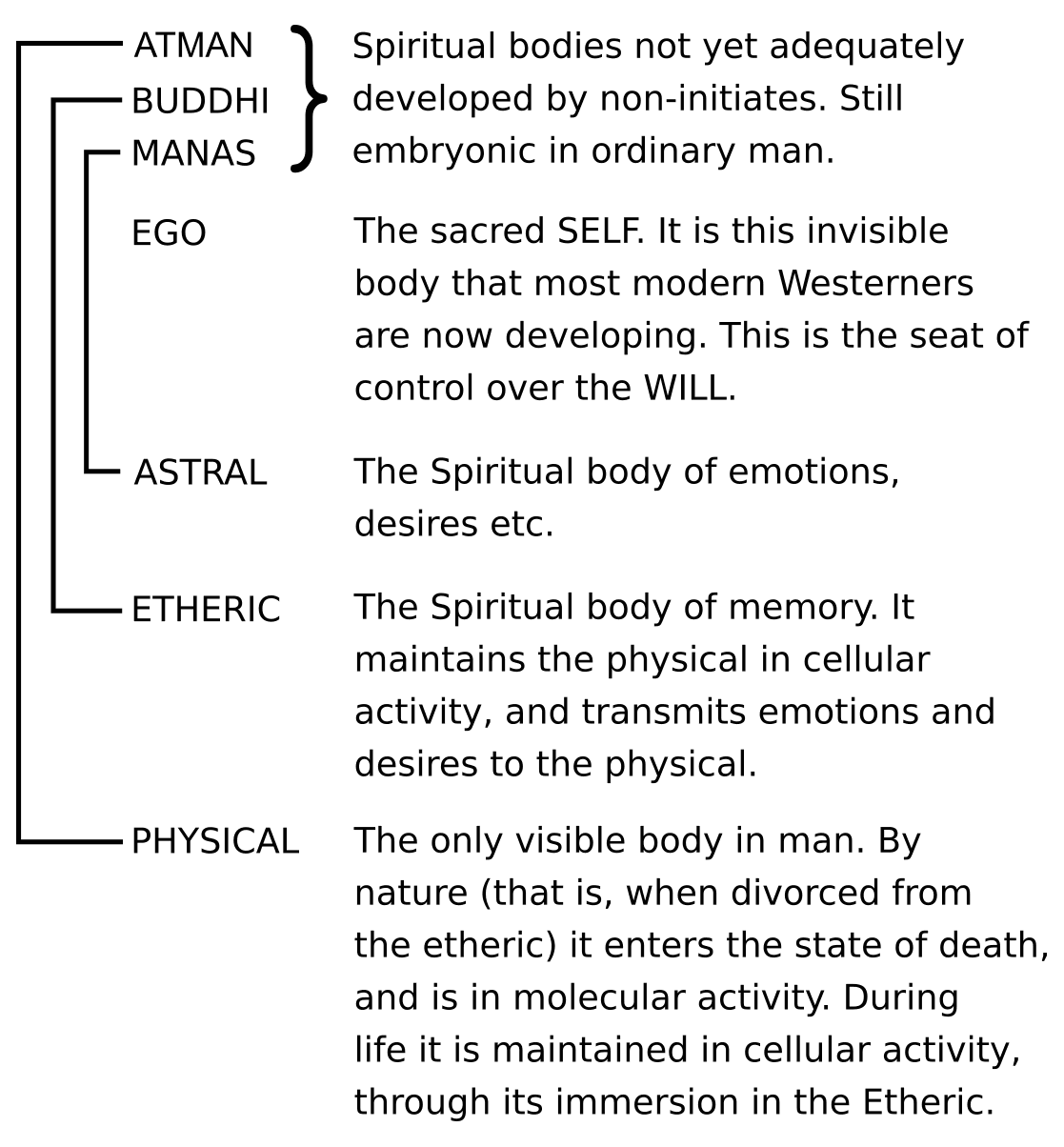(Redirected from Etheric body)
Part of the Casswiki article series Cassiopaean Experiment, Esoterica and Fourth Way
Different teachings make different claims about whether the bodies of the human being includes so-called higher bodies from birth. For example, theosophy and anthroposophy teach that such exist, although their level of perfection may vary a great deal – whereas George Gurdjieff says there are no such things except in rare, esoterically advanced people. It may be that the difference is more a matter of semantics. We can bridge the gap between Gurdjieff and Rudolf Steiner by the system of seven bodies presented by Mark Hedsel.
In theosophy and antroposophy
Rudolf Steiner divides the various bodies of the human being into:
- The physical body which is simply matter.
- The etheric body which is a feature of all living things (including plants), and is the information field that guides the physical growth.
- The astral body which is the container of emotions (also present with higher animals).
- The I which is specific to the human form.
This same division is found in theosophy in general and in various Western and Eastern esoteric traditions under somewhat different names.
In the Fourth Way
George Gurdjieff teaches that the non-physical bodies exist only in potential and need to be constructed by conscious work. Acquiring an astral body is in theory possible but requires generating and holding large amounts of ‘higher hydrogens.’ This astral body is called the body kesdjan in Beelzebub’s Tales to His Grandson. There is another still higher body which is called soul and is composed yet again of a different degree of hydrogen. There is no separate mention of an etheric body in the sense of a field of ‘life force’ guiding the formation of the physical body.
Synthesis
Mark Hedsel discusses a system of seven bodies in The Zelator, starting with the four ones common to theosophy and various other systems, and then continuing with three higher ones that correspond to a higher degree of development. These are called Manas, Buddhi, and Atman. This system of seven bodies provides the means to bridge the gap between the more “conventional” esoteric idea of higher bodies and the Fourth Way teaching.

Table from The Zelator, introductory section “The Way of the Fool”. “The diagram presupposes that Ego is itself a reflecting glass – a sort of mirror of potential – so that the Astral below it is reflected in the Manas above: the Physical is reflected in the highest Atman. […] Sometimes, Atman is ‘Atma’.”
The four first bodies – physical, etheric, astral, and ego (self, “I”) – would correspond to Gurdjieff’s planetary body. The various functions like biological growth and instinct, physical movement, emotion, and thought have their own centers, but these are not treated as separate bodies. The higher being-bodies of Gurdjieff would correspond to Manas, Buddhi, and Atman. In other words, the formation of these would, among other things, correspond to the refinement of emotions and of intellect, and the gaining of access to the corresponding higher centers.
The idea is that there exists a higher variant of emotion and a higher variant of intellect. To these correspond bodies which may be developed, or rather which will construct themselves from the appropriate hydrogens if these hydrogens are produced by the lower organism. For example, the transformation of negative emotions can produce construction material for the body kesdjan and later soul.
The ideas of the higher bodies and of the higher centers are not exactly the same. We could say that constructing the higher bodies corresponds to making the higher functioning permanent.
The astral and the next higher body, variously called atman or soul are the only ones that survive physical death. We can only speak of purposeful reincarnation if these bodies exist and have cohesion. Otherwise we may only speak of “recurrence” – a mechanical recycling of patterns or of looping of one’s “film of life”.
In the Cassiopaean material
The Cassiopaean material divides the human into the physical body, consciousness, the genetic body, and spirit/etheric body. The material does not go particularly deep into their functions or delineations. From the context of usage we could infer that the C’s etheric is whatever survives between incarnations, corresponding to Steiner’s I and parts of astral. The genetic would probably correspond to Steiner’s etheric, meaning an information field whose presence separates living from inanimate matter and consciousness would correspond to transient parts of I and astral. Such comparisons are however of little practical consequence.
